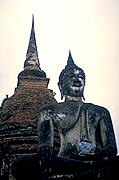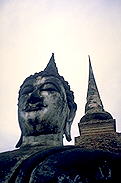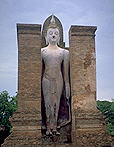The following post was entirely pilfered and paraphrased from
"The Triple Gem: An Introduction to Buddhism" by Gerald Roscoe;
published by Silkworm Books, PO Box 76, Chiang Mai, Thailand 50000. It
seems a mirror reflection of some things I've recently
written. My commentary appears between square brackets: "[", "]".
Concentrate on the passage of breath in and out through your
nostrils, or on the rising and falling of the abdomen.
Try not to let sounds, smells, sights, touch, tastes, and
especially mental activities distract you from the one thing you're
doing: observing your breathing in and breathing out. Do this for at
least ten minutes, try to go twenty minutes, even longer. Do it every
day, morning or evening, or both.
Now, although I've described it as simple to do, it's not
simple to do effectively. The mind is not easily stilled. So, don't
be impatient when your mind jumps, as it will. In the middle of an in-breath
your mind will jump to a business problem, a family problem, a sensual
thought, a pleasant memory, a distasteful one. You'll hear a door being
slammed, an airplane overhead, a baby crying, a radio playing, a horn
honking. . . Just try to ignore these distractions and get back to your
concentration on breathing in and breathing out. At first as you practice
meditation, you'll be able to ignore distractions for a few seconds,
even a few minutes. You will not be able to ignore them for the entire
time of your meditation. But no matter. Even a brief stilling of the
mind is beneficial. (Some meditators--monks, especially--do succeed
in stilling the mind for long enough periods of time to enter deep states
of absorption and concentration--called jhanas [Zen Climbing? ;-]--in
which there is one-pointedness of mind and there are no distractions
affecting the mind, no sensations other than happiness, joy, insight.)
The Buddha said: the mind is flighty, difficult to subdue,
flitting wherever it chooses. To tame the mind is good. A mind tamed
can bring happiness.
For many Western meditators the beneficial effects of Samatha
are sufficient rewards for their effort: calm, serenity, tranquillity,
lessening the tensions. But there are, of course, other effects which
the consistent meditator ultimately perceives: the realization that
the self is not the master of sensory perceptions or mental activities;
the recognition of impermanence and constant change; in short the awareness
or the insight-wisdom that is the goal of the form of meditation known
as Vipassana.



An Island Wat at Sukhothai
|
When I was first introduced to meditation at Wat Saket in
Bangkok [NEAT! Went there yesterday!], after two weeks of practice I
asked the meditation master what I was supposed to get out of it and
what my goals in meditation should be. I was told, don't ask, just do.
I found that answer not very helpful, and I regret, now, that I was
not told that my meditations were intended to still my mind and induce
insight-wisdom. Had I been told, my meditation practice would have been
more effective more quickly. But I also understand, now, that the meditation
master was not being flippant or unresponsive in his "don't ask,
just do". For some people-and this is what Zen masters believe-"just
doing" leads to an understanding of why they are meditating. For
me it did not. I mention this because many of my Western friends, like
me at first, become discouraged if they "just do" without
understanding why. [On the other hand, as with Anna during the climb
up Kinabalu (see the Mount Kinabalu series),
the answer to the question "why?" can be learned effectively
but taught only poorly. I explained "why" to her, and she
nodded her head and made a perfunctory effort, but the full import,
the insight-wisdom of "why" remained unclear until she "just
did it".]
Many meditation teachers recommend the use of a mantra, the
most popular of which among Theravadin [Buddhist sect popular in Thailand,
Burma, Cambodia and Sri Lanka] is the Buddho mantra: the silent
wording of Bud- on each in breath, -dho on each out-breath. Bud-dho...Bud-dho...Bud-dho...
[Or the Zen Climber favourites: Clementine
or Waltzing Matilda. A little long as most
Mantras go, but one well suited to meditative endurance.]
One may also practice the breathing meditation before going
to sleep, while lying in bed, preferably in what is called the "lion"
position, on the right side, right hand on or beside the head, left
arm on top of left side.
A second method of Samatha cultivation is the walking meditation,
very popular in the East, less so in the West [particularly youthful
English climber wannabies]. In one of its
forms, the meditator walks slowly back and forth, in a natural, harmonious
pace, hands held loosely in front of the body or in back, eyes lowered
to a spot six feet or so in advance of one's walking, being aware simply
of each footfall. In another form, one is mindful of each and
every movement and action of walking: left foot rising, moving forward,
coming down. Right foot rising, moving forward coming down. Stopping.
Turning. Moving forward again. Left foot rising . . . and so on.
Notice that one does not think my left foot, my
right foot, does not think I am stopping, I am turning. Thus, in addition
to being a Samatha form of meditation inducing calm, it is also
a Vipassana form inducing insight-wisdom into the nature of no-self.
Vipassana meditation, as contrasted with Samatha, is the specific
mental cultivation of awareness. Whereas in Samatha one ignores
sensory, mental, and physical actions and diversions, in Vipassana one
intentionally notices them. One is totally mindful. It can be,
on a meditation retreat, an intense and demanding exercise. For minutes,
hours, even days, [or climbing hundreds of meters in elevation,] the
meditator concentrates on noticing every action, every thought, every
feeling. When eating, for example, one is aware of the fork rising,
coming to the mouth, of the food in the mouth, of the food being chewed,
being swallowed, of the fork moving away, of the fork being put down.
And so with everything one does or thinks, one strives to be
aware and mindful of what is happening in the most minute detail.



Buddhas: standing, miniature and missing
at Sukhothai
|
Some meditators practice the breathing in breathing out meditation
not only for calm (Samatha) but also simultaneously for insight (Vipassana).
If a distraction arises instead of ignoring it they are mindful of it,
observing the kinetics of the mind: "thinking-thinking-thinking,
remembering-remembering-remembering, planning-planning-planning",
etc. in appropriate response to the distraction. And then they return
to observation of breathing until the next distraction commands their
mindfulness.
The goal of Vipassana is the realization that the five aggregates,
the Khandas--body, feelings, perceptions, intentions and volitions (mental
formations), and acts of consciousness--are constantly taking place
independently of the "self"; that there is no "self",
no "I", at their controls. Such awareness frees one from the
attachment to "self", of the aggregates, thus inducing insight-wisdom
about the Three Characteristics of Existence (impermanence, no-self,
dukkha [suffering]).
Whether meditating for calm or for insight, effective meditation
is difficult to accomplish. The Buddha identified five hindrances to
effective meditation: the desire for sensual pleasure, ill will, lethargy-and-drowsiness,
agitation-and-worry, and uncertainty. These hindrances deter many from
realizing the benefits of meditation.
Patrick. -- Responses Sought --